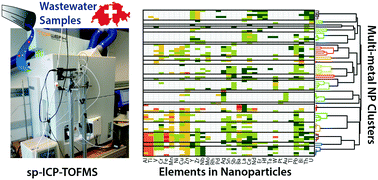Emerging investigator series: automated single-nanoparticle quantification and classification: a holistic study of particles into and out of wastewater treatment plants in Switzerland†
Abstract
Single particle inductively coupled plasma time-of-flight mass spectrometry (sp-ICP-TOFMS), in combination with online microdroplet calibration, allows for the determination of particle number concentrations (PNCs) and the amount (i.e. mass) of ICP-MS-accessible elements in individual particles. Because sp-ICP-TOFMS analyses of environmental samples produce rich datasets composed of both single-metal nanoparticles (smNPs) and many types of multi-metal NPs (mmNPs), interpretation of these data is well suited to automated analysis schemes. Here, we present a new data analysis approach that includes: 1. automatic particle detection and elemental mass determinations based on online microdroplet calibration, 2. correction of false (randomly occurring) multi-metal associations caused by measurement of coincident but distinct NPs, and 3. unsupervised clustering analysis of mmNPs to identify unique classes of NPs based on their element compositions. To demonstrate the potential of our approach, we analyzed water samples collected from the influent and effluent of five wastewater treatment plants (WWTPs) across Switzerland. We determined elemental masses in individual NPs, as well as PNCs, to estimate the NP removal efficiencies of the individual WWTPs. From WWTP samples collected at two points in time, we found an average of 90% and 94% removal efficiencies of single-metal and multi-metal NPs, respectively. Between 5% to 27% of detected NPs were multi-metal; the most abundant particle types were those rich in Ce–La, Fe–Al, Ti–Zr, and Zn–Cu. Through hierarchical clustering, we identified NP classes conserved across all WWTPs, as well as particle types that are unique to one or a few WWTPs. These uniquely occurring particle types may represent point sources of anthropogenic NPs. We describe the utility of clustering analysis of mmNPs for identifying natural, geogenic NPs, and also for the discovery of new, potentially anthropogenic, NP targets.

- This article is part of the themed collections: Recent Open Access Articles, Environmental Science: Nano Recent HOT Articles, Best Papers 2021 - Environmental Science: Nano and Emerging Investigators Series


 Please wait while we load your content...
Please wait while we load your content...